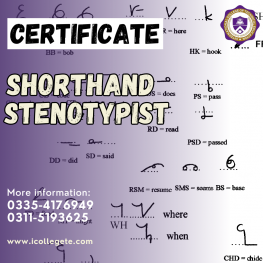
In a fast-paced world where information is constantly flowing, the ability to capture and transcribe spoken words quickly is a valuable skill. This is where the Basic Shorthand Course becomes a game-changer. Designed to equip individuals with the tools needed to take efficient notes, this course is a gateway to enhanced productivity and effective communication.
Course Benefits:
The Basic Shorthand Course is more than just learning to write faster; it’s about unlocking a world of benefits that extend across various domains. Participants in this course can expect to:
- Enhanced Note-Taking Speed: The primary benefit of this course is the ability to transcribe spoken words at a significantly accelerated pace. This skill is invaluable in settings where information is conveyed rapidly, such as lectures, meetings, or interviews.
- Increased Productivity: By mastering shorthand, individuals can streamline their note-taking process, reducing the time spent on writing and allowing for more focus on the content itself. This results in increased productivity in both academic and professional settings.
- Improved Memory Retention: Shorthand promotes active listening and selective recording of essential information. This process not only aids in capturing key details but also enhances memory retention, making it easier to recall information when needed.
Learning Outcomes:
Upon completion of the Basic Shorthand Course, participants can expect to achieve the following learning outcomes:
- Mastery of Shorthand Symbols: Develop a comprehensive understanding of shorthand symbols and their application in real-time note-taking.
- Increased Writing Speed: Drastically improve writing speed while maintaining accuracy, ensuring the ability to keep up with fast-paced verbal communication.
- Effective Transcription Skills: Acquire the ability to transcribe shorthand notes efficiently, translating them into clear, legible text.
- Adaptability in Various Contexts: Apply shorthand skills across different scenarios, from academic lectures to business meetings, demonstrating versatility in note-taking.
Study Units:
The Basic Shorthand Course is structured to cover essential units, including:
- Introduction to Shorthand: Understand the history and significance of shorthand, laying the foundation for the course.
- Shorthand Symbols and Rules: Dive into the core symbols and rules governing shorthand writing, ensuring a solid grasp of the fundamentals.
- Speed Building Exercises: Engage in practical exercises designed to enhance writing speed and accuracy progressively.
- Real-Life Applications: Explore how shorthand can be effectively applied in various contexts, from educational settings to professional environments.
Who is this Course For:
The Basic Shorthand Course is tailored for:
- Students: Ideal for students who wish to optimize their note-taking during lectures, ensuring they capture crucial information without missing a beat.
- Professionals: Valuable for professionals in fields where rapid information processing is essential, such as journalism, secretarial work, or court reporting.
- Anyone Seeking Efficiency: Open to individuals who recognize the importance of efficient communication and wish to enhance their productivity through improved note-taking skills.
Future Progression:
Completing the Basic Shorthand Course opens the door to further skill development and specialization. Graduates may consider advanced shorthand courses, explore stenography, or even pursue careers in transcription services. The ability to transcribe information swiftly is a skill that continues to be in demand across various industries, making the Basic Shorthand Course a stepping stone to a more efficient and successful future. Embrace the power of shorthand and unlock a world of possibilities!

